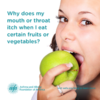Did you know pollen might be responsible for your allergic reactions to fruit or vegetables? If your mouth or throat itches when you eat certain fruit or vegetables, you could have oral allergy syndrome (OAS). And you would have a pollen allergy to thank for that.
1. Cross-reactivity is the reason for OAS symptoms. OAS is the result of a confused immune system. The pollen of some trees and grasses are similar to the proteins of certain raw fruits, vegetables, seed or nuts.
2. Birch, alder, ragweed, mugwort, Timothy grass and orchard grass pollen cause most OAS symptoms. These pollens are similar to the proteins of certain raw fruits, vegetables, seed or nuts. If you are allergic to any of these pollens, you may have OAS symptoms.
3. You may be able to eat foods that cause OAS symptoms if you remove their skins and/or cook them. Heat affects the proteins, so you may be able to eat these foods cooked instead of raw. For example, a fresh apple may cause symptoms, but a person with OAS may be able to eat applesauce without symptoms.
4. If you’re allergic to these pollens but don’t have symptoms when eating related foods, you can still eat them. But if you have severe OAS symptoms, avoid those foods and talk to your allergist.
5. Your OAS symptoms may be worse when pollen peaks. For example, birch trees release pollen January through April, depending on where you live. Ragweed pollen season is in the summer and fall. You may notice that your symptoms are worse during the times when the pollen you are allergic to is highest.
6. OAS can be confused with food allergy. It can cause symptoms such as an itchy or tingling mouth, face, tongue or throat. You may also have some mouth and throat swelling or hives where the food touched your skin. Rarely, OAS can trigger anaphylaxis, a severe allergic reaction, so it is important to know if you have OAS or a food allergy and how to treat it.
7. If you have OAS symptoms to nuts, this could actually be signs of anaphylaxis, a serious allergic reaction. If you have any symptoms while eating nuts, see a board-certified allergist as soon as possible. Nuts are more likely to cause a serious allergic reaction which must be treated with epinephrine and immediate medical attention. And if you don’t know if you are having OAS symptoms or anaphylaxis to any foods, talk to your allergist.
Here is a list of some pollens and the foods they may cross-react with. You may not react to every food on the list.
Birch Tree Pollen Cross-Reactions
- Almond
- Apple
- Apricot
- Carrot
- Celery
- Cherry
- Hazelnut
- Kiwi
- Parsley
- Peach
- Peanut
- Pear
- Plum
- Soybean
Alder Tree Pollen Cross-Reactions
- Almond
- Apple
- Celery
- Cherry
- Hazelnut
- Peach
- Pear
- Parsley
Ragweed Pollen Cross-Reactions
- Banana
- Cantaloupe
- Cucumber
- Honeydew
- Watermelon
- White potato
- Zucchini
Mugwort Weed Pollen Cross-Reactions
- Aniseed
- Bell pepper
- Black pepper
- Broccoli
- Cabbage
- Caraway
- Cauliflower
- Chard
- Coriander
- Fennel
- Garlic
- Onion
- Parsley
Timothy and Orchard Grass Pollen Cross-Reactions
- Orange
- Peach
- Tomato
- Watermelon
- White Potato


Comments (24)